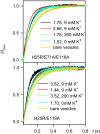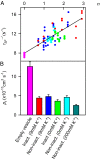Filter gate closure inhibits ion but not water transport through potassium channels
- PMID: 23754382
- PMCID: PMC3696751
- DOI: 10.1073/pnas.1304714110
Filter gate closure inhibits ion but not water transport through potassium channels
Abstract
The selectivity filter of K(+) channels is conserved throughout all kingdoms of life. Carbonyl groups of highly conserved amino acids point toward the lumen to act as surrogates for the water molecules of K(+) hydration. Ion conductivity is abrogated if some of these carbonyl groups flip out of the lumen, which happens (i) in the process of C-type inactivation or (ii) during filter collapse in the absence of K(+). Here, we show that K(+) channels remain permeable to water, even after entering such an electrically silent conformation. We reconstituted fluorescently labeled and constitutively open mutants of the bacterial K(+) channel KcsA into lipid vesicles that were either C-type inactivating or noninactivating. Fluorescence correlation spectroscopy allowed us to count both the number of proteoliposomes and the number of protein-containing micelles after solubilization, providing the number of reconstituted channels per proteoliposome. Quantification of the per-channel increment in proteoliposome water permeability with the aid of stopped-flow experiments yielded a unitary water permeability pf of (6.9 ± 0.6) × 10(-13) cm(3)⋅s(-1) for both mutants. "Collapse" of the selectivity filter upon K(+) removal did not alter pf and was fully reversible, as demonstrated by current measurements through planar bilayers in a K(+)-containing medium to which K(+)-free proteoliposomes were fused. Water flow through KcsA is halved by 200 mM K(+) in the aqueous solution, which indicates an effective K(+) dissociation constant in that range for a singly occupied channel. This questions the widely accepted hypothesis that multiple K(+) ions in the selectivity filter act to mutually destabilize binding.
Keywords: aquaporin; brain water homeostasis; knock-on mechanism; membrane channels; protein reconstitution.
Conflict of interest statement
The authors declare no conflict of interest.
Figures





Similar articles
-
Molecular determinants of gating at the potassium-channel selectivity filter.Nat Struct Mol Biol. 2006 Apr;13(4):311-8. doi: 10.1038/nsmb1069. Epub 2006 Mar 12. Nat Struct Mol Biol. 2006. PMID: 16532009
-
Pore hydration states of KcsA potassium channels in membranes.J Biol Chem. 2015 Oct 30;290(44):26765-75. doi: 10.1074/jbc.M115.661819. Epub 2015 Sep 14. J Biol Chem. 2015. PMID: 26370089 Free PMC article.
-
Voltage-dependent gating at the KcsA selectivity filter.Nat Struct Mol Biol. 2006 Apr;13(4):319-22. doi: 10.1038/nsmb1070. Epub 2006 Mar 12. Nat Struct Mol Biol. 2006. PMID: 16532008
-
The potassium channel KcsA and its interaction with the lipid bilayer.Cell Mol Life Sci. 2003 Aug;60(8):1581-90. doi: 10.1007/s00018-003-3172-y. Cell Mol Life Sci. 2003. PMID: 14513833 Free PMC article. Review.
-
Structural correlates of selectivity and inactivation in potassium channels.Biochim Biophys Acta. 2012 Feb;1818(2):272-85. doi: 10.1016/j.bbamem.2011.09.007. Epub 2011 Sep 16. Biochim Biophys Acta. 2012. PMID: 21958666 Free PMC article. Review.
Cited by
-
Water Dynamics in a Peptide-appended Pillar[5]arene Artificial Channel in Lipid and Biomimetic Membranes.Front Chem. 2021 Oct 29;9:753635. doi: 10.3389/fchem.2021.753635. eCollection 2021. Front Chem. 2021. PMID: 34778209 Free PMC article.
-
Unidirectional photoreceptor-to-Müller glia coupling and unique K+ channel expression in Caiman retina.PLoS One. 2014 May 15;9(5):e97155. doi: 10.1371/journal.pone.0097155. eCollection 2014. PLoS One. 2014. PMID: 24831221 Free PMC article.
-
Molecular cloning, overexpression and characterization of a novel water channel protein from Rhodobacter sphaeroides.PLoS One. 2014 Jan 31;9(1):e86830. doi: 10.1371/journal.pone.0086830. eCollection 2014. PLoS One. 2014. PMID: 24497982 Free PMC article.
-
The Sodium Glucose Cotransporter SGLT1 Is an Extremely Efficient Facilitator of Passive Water Transport.J Biol Chem. 2016 Apr 29;291(18):9712-20. doi: 10.1074/jbc.M115.706986. Epub 2016 Mar 4. J Biol Chem. 2016. PMID: 26945065 Free PMC article.
-
Native Function of the Bacterial Ion Channel SthK in a Sparsely Tethered Lipid Bilayer Membrane Architecture.J Phys Chem B. 2023 Apr 27;127(16):3641-3650. doi: 10.1021/acs.jpcb.2c07252. Epub 2023 Apr 18. J Phys Chem B. 2023. PMID: 37072125 Free PMC article.
References
-
- Bezanilla F. The action potential: From voltage-gated conductances to molecular structures. Biol Res. 2006;39(3):425–435. - PubMed
-
- Miller C. See potassium run. Nature. 2001;414(6859):23–24. - PubMed
-
- Doyle DA, et al. The structure of the potassium channel: Molecular basis of K+ conduction and selectivity. Science. 1998;280(5360):69–77. - PubMed
-
- Zhou Y, Morais-Cabral JH, Kaufman A, MacKinnon R. Chemistry of ion coordination and hydration revealed by a K+ channel-Fab complex at 2.0 A resolution. Nature. 2001;414(6859):43–48. - PubMed
Publication types
MeSH terms
Substances
Grants and funding
LinkOut - more resources
Full Text Sources
Other Literature Sources

